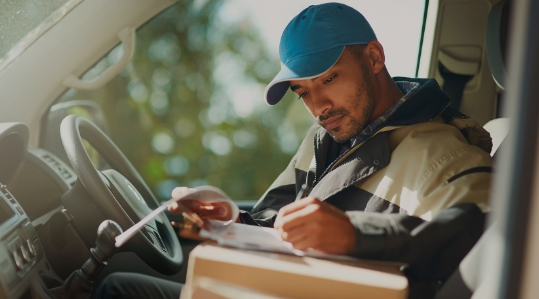
Delivery drivers play a pivotal role in the modern economy, ensuring that goods and services reach their intended destinations in a timely and efficient manner. Whether transporting packages, groceries, or meals, delivery drivers are essential contributors to the smooth functioning of supply chains and the convenience of consumers. In this comprehensive exploration, we delve into the multifaceted world of delivery drivers, covering their roles, responsibilities, challenges, industry dynamics, and the evolving landscape of the logistics sector.
Introduction to Delivery Drivers
1 Defining the Role of Delivery Drivers
Delivery drivers, also known as couriers or drivers, are professionals responsible for transporting goods from one location to another. Their tasks range from delivering online orders and groceries to transporting medical supplies and facilitating the movement of various commodities.
2 Significance of Delivery Services
Delivery services have become integral to the fabric of modern commerce, driven by the rise of e-commerce, the convenience economy, and the changing expectations of consumers. Delivery drivers bridge the gap between businesses and customers, facilitating the last-mile delivery crucial for customer satisfaction.
Roles and Responsibilities of Delivery Drivers
1 Package Pickup and Verification
One of the primary responsibilities of delivery drivers is the pickup of packages from distribution centers, warehouses, or businesses. This involves verifying the accuracy of the items received, checking for any damages, and ensuring that the packages match the corresponding documentation.
2 Efficient Route Planning and Navigation
Delivery drivers must plan and optimize their routes to ensure timely deliveries. Navigational skills are crucial for finding the most efficient paths, avoiding traffic, and minimizing delivery times.
3 Package Handling and Security
Ensuring the safe handling of packages is paramount. Delivery drivers must load and unload items with care, preventing damage during transit. They are also responsible for securing packages to prevent theft or loss.
4 Customer Interaction and Service
In cases where drivers have direct interaction with customers during deliveries, providing excellent customer service is essential. This includes clear communication, friendly demeanor, and addressing any customer inquiries or concerns.
5 Record-Keeping and Documentation
Accurate record-keeping is a crucial aspect of a delivery driver’s role. This includes obtaining customer signatures, documenting delivery times, and ensuring that all necessary paperwork is in order.
Types of Delivery Driver Jobs
1 E-commerce Delivery Drivers
With the exponential growth of online shopping, e-commerce delivery drivers are in high demand. They transport packages from warehouses or distribution centers to residential addresses, ensuring that customers receive their orders promptly.
2 Food Delivery Drivers
Food delivery drivers play a significant role in the restaurant and food industry. They transport meals from restaurants to customers’ homes, workplaces, or other specified locations, often using specialized thermal bags to maintain food freshness.
3 Grocery Delivery Drivers
Grocery delivery drivers work for supermarkets or online grocery platforms, delivering groceries directly to customers’ doorsteps. This type of delivery service has gained popularity, providing convenience for individuals who prefer to have their groceries delivered.
4 Parcel Delivery Drivers
Parcel delivery drivers handle a broad range of items, including documents, packages, and parcels. They may work for courier companies, logistics providers, or as independent contractors, transporting items of varying sizes and weights.
Educational and Licensing Requirements
1 Educational Background
The educational requirements for delivery driver positions are generally minimal. A high school diploma or equivalent is often sufficient. Basic literacy and numeracy skills are essential for tasks such as reading addresses and maintaining accurate records.
2 Driver’s License
Possessing a valid driver’s license is a fundamental requirement for delivery drivers. The type of license may vary depending on the size and type of vehicle used for deliveries. Commercial driver’s licenses (CDL) may be required for larger vehicles.
3 Training Programs
While formal education may not be mandatory, some employers provide on-the-job training for new delivery drivers. Training programs may cover safe driving practices, customer service skills, and the use of delivery tracking systems.
4 Vehicle Requirements
Delivery drivers must have access to a reliable and appropriately sized vehicle for their specific type of deliveries. In some cases, employers may provide company-owned vehicles, while others may require drivers to use their own vehicles.
Skills and Attributes of Successful Delivery Drivers
1 Time Management
Time management skills are crucial for delivery drivers to ensure that they adhere to delivery schedules and meet deadlines. Efficient route planning and timely deliveries contribute to customer satisfaction.
2 Communication Skills
Clear and effective communication is vital, especially in roles where drivers interact directly with customers. Good communication helps build positive relationships and ensures that customers are informed about their deliveries.
5.3 Navigation Skills
Navigational proficiency is essential for delivery drivers to find the most efficient routes. Familiarity with GPS systems and mapping tools enhances a driver’s ability to navigate through varying traffic conditions.
4 Physical Fitness
Delivery drivers often engage in physical tasks such as lifting and carrying packages. Physical fitness is essential for handling these tasks without compromising personal well-being.
5 Problem-Solving Abilities
Delivery drivers encounter various challenges, including traffic congestion, unexpected road closures, and customer-related issues. Problem-solving skills enable drivers to address these challenges effectively.
Challenges Faced by Delivery Drivers
1 Traffic Conditions
Delivery drivers often navigate through busy urban areas with traffic congestion. Dealing with traffic delays adds complexity to route planning and can impact delivery times.
2 Weather Conditions
Adverse weather conditions, such as rain, snow, or extreme temperatures, pose challenges for delivery drivers. Weather-related disruptions can affect the safety of deliveries and impact overall efficiency.
3 Time Sensitivity
Many delivery services operate on tight schedules, particularly with the rise of same-day or express deliveries. Meeting time-sensitive expectations is a constant challenge for delivery drivers.
4 Security Concerns
Ensuring the security of packages is a significant concern. Delivery drivers need to implement measures to prevent theft or damage during transit and ensure that deliveries reach the correct recipients.
5 Customer Expectations
Meeting customer expectations for timely and accurate deliveries is a challenge. With the growth of e-commerce, customers increasingly expect real-time tracking, precise delivery windows, and convenient options.
Technological Advances in Delivery Services
1 GPS and Route Optimization
Global Positioning System (GPS) technology is widely used in delivery services for route optimization. GPS systems assist drivers in finding the most efficient routes, avoiding traffic, and minimizing delivery times.
2 Delivery Tracking Systems
Advanced tracking systems provide real-time monitoring of packages during transit. Customers can track the status and location of their deliveries, contributing to transparency and customer satisfaction.
3 Mobile Apps for Delivery Drivers
Many delivery services provide drivers with mobile apps that streamline communication, track deliveries, and provide access to relevant information. Mobile apps contribute to the overall efficiency and connectivity of delivery operations.
4 Autonomous Delivery Vehicles
The exploration of autonomous vehicles for deliveries is an emerging trend. Companies are experimenting with drones and autonomous ground vehicles to enhance the efficiency of delivery operations.
5 Contactless Delivery
The COVID-19 pandemic accelerated the adoption of contactless delivery options. Many delivery services now offer contactless drop-offs, allowing customers to receive their packages without direct physical contact.
Future Trends in Delivery Services
1 Drone Deliveries
The use of drones for deliveries is an area of ongoing exploration. While regulatory challenges exist, the potential for drone deliveries to enhance speed and reach, especially in remote areas, is being actively studied.
2 Artificial Intelligence in Logistics
Artificial intelligence (AI) is being integrated into logistics and delivery operations. AI-driven systems can optimize routes, predict delivery times more accurately, and enhance overall operational efficiency.
3 Sustainability Initiatives
Sustainability is becoming a focal point in the delivery industry. Some companies are exploring eco-friendly delivery options, such as electric vehicles or bicycle couriers, to reduce their environmental impact.
4 Robotics in Warehousing
Automation and robotics are being increasingly utilized in warehousing, impacting the efficiency of order fulfillment. Automated warehouses and robotic picking systems contribute to faster and more accurate order processing.
5 Hyperlocal Delivery Networks
The development of hyperlocal delivery networks aims to streamline deliveries within specific neighborhoods or communities. This trend is geared towards reducing delivery times and increasing overall efficiency.
Conclusion
Delivery drivers serve as the linchpin in the logistics chain, facilitating the movement of goods and services with precision and speed. The evolution of delivery services, influenced by technological advancements, changing consumer expectations, and global events, presents both challenges and opportunities for those in the profession.
As the landscape of delivery services continues to transform, delivery drivers will play a vital role in adapting to new technologies, embracing sustainability initiatives, and meeting the evolving needs of businesses and consumers. The resilience, adaptability, and dedication of delivery drivers contribute to the overall success of logistics operations and the satisfaction of customers who rely on the timely receipt of their orders.
In navigating the dynamic world of delivery services, it is crucial for industry stakeholders, policymakers, and delivery drivers themselves to collaboratively address challenges, embrace innovations, and ensure that the delivery ecosystem remains robust, efficient, and responsive to the demands of a rapidly changing market. The journey of a delivery driver extends beyond the miles traveled; it is a journey of reliability, service, and fulfillment, connecting businesses and customers in the tapestry of a globalized and interconnected world.







